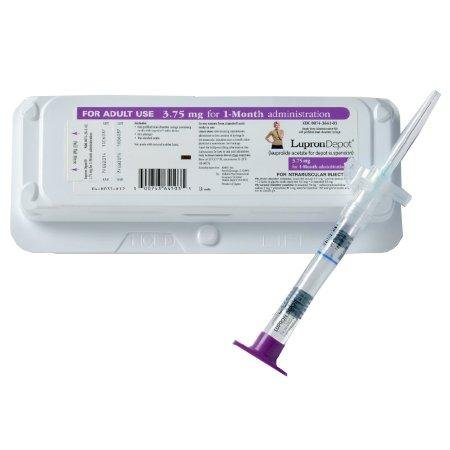Generic Lupron Depot Availability
Last updated on Aug 6, 2025.
Lupron Depot is a brand name of leuprolide, approved by the FDA in the following formulation(s):
LUPRON DEPOT (leuprolide acetate - injectable;injection)
-
Manufacturer: ABBVIE ENDOCRINE INC
Approval date: January 26, 1989
Strength(s): 7.5MG [RLD] -
Manufacturer: ABBVIE ENDOCRINE INC
Approval date: October 22, 1990
Strength(s): 3.75MG/VIAL (discontinued) [RLD] -
Manufacturer: ABBVIE ENDOCRINE INC
Approval date: October 26, 1995
Strength(s): 3.75MG [RLD] -
Manufacturer: ABBVIE ENDOCRINE INC
Approval date: December 22, 1995
Strength(s): 22.5MG [RLD] -
Manufacturer: ABBVIE ENDOCRINE INC
Approval date: March 7, 1997
Strength(s): 11.25MG [RLD] -
Manufacturer: ABBVIE ENDOCRINE INC
Approval date: May 30, 1997
Strength(s): 30MG [RLD] -
Manufacturer: ABBVIE ENDOCRINE INC
Approval date: June 17, 2011
Strength(s): 45MG [RLD]
Is there a generic version of Lupron Depot available?
No. There is currently no therapeutically equivalent version of Lupron Depot available in the United States.
Note: Fraudulent online pharmacies may attempt to sell an illegal generic version of Lupron Depot. These medications may be counterfeit and potentially unsafe. If you purchase medications online, be sure you are buying from a reputable and valid online pharmacy. Ask your health care provider for advice if you are unsure about the online purchase of any medication.
See also: Generic Drug FAQ.
Related patents
Patents are granted by the U.S. Patent and Trademark Office at any time during a drug's development and may include a wide range of claims.
-
Sustained-release composition and method for producing the same
Patent 8,921,326
Issued: December 30, 2014
Inventor(s): Futo Tomomichi & Saito Kazuhiro & Hoshino Tetsuo & Hori Masuhisa
Assignee(s): Takeda Pharmaceutical Company LimitedSustained-release compositions wherein a water-soluble physiologically active peptide is substantially uniformly dispersed in a microcapsule comprised of a lactic acid polymer or a salt thereof, and the physiologically active substance is contained in an amount of 15 to 35 wt/wt % to the total microcapsules and weight-average molecular weight (Mw) of the lactic acid polymer is about 11,000 to about 27,000, which is characterized by having a high content of the physiologically active substance, and suppression of the initial excessive release within one day after the administration and a stable drug sustained-release over a long period of time, and method for producing the same.
Patent expiration dates:
- February 5, 2031✓✓
- February 5, 2031
-
Sustained-release composition and method for producing the same
Patent 9,617,303
Issued: April 11, 2017
Inventor(s): Futo Tomomichi & Saito Kazuhiro & Hoshino Tetsuo & Hori Masuhisa
Assignee(s): Takeda Pharmaceutical Company LimitedSustained-release compositions wherein a water-soluble physiologically active peptide is substantially uniformly dispersed in a microcapsule comprised of a lactic acid polymer or a salt thereof, and the physiologically active substance is contained in an amount of 15 to 35 wt/wt % to the total microcapsules and weight-average molecular weight (Mw) of the lactic acid polymer is about 11,000 to about 27,000, which is characterized by having a high content of the physiologically active substance, and suppression of the initial excessive release within one day after the administration and a stable drug sustained-release over a long period of time, and method for producing the same.
Patent expiration dates:
- March 22, 2028✓
- March 22, 2028
More about Lupron Depot (leuprolide)
- Check interactions
- Compare alternatives
- Pricing & coupons
- Reviews (242)
- Drug images
- Side effects
- Dosage information
- Patient tips
- During pregnancy
- Support group
- Drug class: gonadotropin releasing hormones
- En español
Patient resources
Other brands
Eligard, Camcevi, Fensolvi, Viadur
Professional resources
Other brands
Eligard, Camcevi, Lupron Depot-Gyn, Fensolvi, Lutrate Depot
Other formulations
Related treatment guides
Related/similar drugs
Glossary
| Term | Definition |
|---|---|
| Drug Patent | A drug patent is assigned by the U.S. Patent and Trademark Office and assigns exclusive legal right to the patent holder to protect the proprietary chemical formulation. The patent assigns exclusive legal right to the inventor or patent holder, and may include entities such as the drug brand name, trademark, product dosage form, ingredient formulation, or manufacturing process A patent usually expires 20 years from the date of filing, but can be variable based on many factors, including development of new formulations of the original chemical, and patent infringement litigation. |
| Drug Exclusivity | Exclusivity is the sole marketing rights granted by the FDA to a manufacturer upon the approval of a drug and may run simultaneously with a patent. Exclusivity periods can run from 180 days to seven years depending upon the circumstance of the exclusivity grant. |
| RLD | A Reference Listed Drug (RLD) is an approved drug product to which new generic versions are compared to show that they are bioequivalent. A drug company seeking approval to market a generic equivalent must refer to the Reference Listed Drug in its Abbreviated New Drug Application (ANDA). By designating a single reference listed drug as the standard to which all generic versions must be shown to be bioequivalent, FDA hopes to avoid possible significant variations among generic drugs and their brand name counterpart. |
Further information
Always consult your healthcare provider to ensure the information displayed on this page applies to your personal circumstances.

